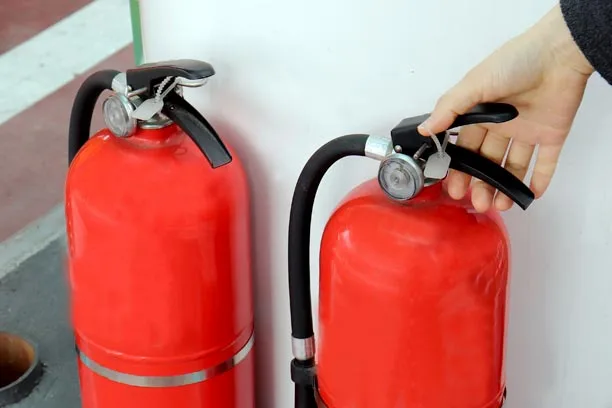All the Places You Need Fire Extinguishers on Your Farm


A fire can be deadly and can wreak havoc on your farm business as well. That’s why it’s important to consider this question: If a fire breaks out on your farm, will you be ready? To handle a fire on your farm, you need the proper safety equipment in place — and that means having the right types of fire extinguishers stored in all the right places. Whether it’s a fire extinguisher for your excavator, fire extinguishers for farm equipment or other types of fire extinguishers, keeping them handy helps you protect your farm by preventing fires from worsening.
Here's what to know about having fire extinguishers on your farm and tips for maximizing your safety.
There are several types of fire extinguishers available, but farms have special needs. That’s why the best type of fire extinguisher for farm use is a multipurpose “ABC” type.
Extinguishers are rated for the type of fire they’re made to extinguish:
ABC extinguishers generally use ammonium phosphate as the active chemical to extinguish a fire, and they can put out most common fires. That kind of versatility is especially helpful on a farm.
Multipurpose fire extinguishers are available in three sizes: 2.5 pounds, 5 pounds and 10 pounds. If you’re deciding on which size to get, remember that the larger the extinguisher, the longer it takes to completely discharge. Because the discharge time for these sizes ranges from 8 to 25 seconds, a 5-pound extinguisher is the minimum size that should be purchased for farm buildings and equipment. However, consider if a larger fire extinguisher will be better for your needs.
This is common sense, but it bears repeating: a fire extinguisher is most useful when it’s near the fire itself. So, when you’re thinking about the placement of your extinguishers, consider where a fire is most likely to break out. You should store fire extinguishers near farm equipment at risk of catching ablaze — here are some things to consider.
You want to protect all of your farm buildings, of course. So, it’s good to have at least one fire extinguisher in each of your farm buildings. That said, your farm shop is particularly fire prone due to the types of equipment and chemicals often kept in your shop. So, make sure you’ve got a fire extinguisher in an easy-to-access spot nearby.
Protect your equipment well by making sure you could swiftly extinguish a fire. You should mount fire extinguishers on all tractors, combines, trucks and other equipment. To cut down on the cost of purchasing several fire extinguishers, mounting brackets can be attached to equipment and the extinguisher can be transferred between seasonal equipment when it’s not in use.
It’s a good idea to mount your fire extinguishers at eye level and near exits. That way, in the event of a fire, your escape route and path to an extinguisher location are the same, making it easy to grab the extinguisher as you move toward safety. If the fire is of a size that you can tackle with an extinguisher, you’ll still have your escape route at your back if things get out of hand.
When using an extinguisher, discharge the contents fully to ensure the blaze is out. Once an extinguisher is activated, it will no longer hold pressure over the long term and will need to go to a service facility to be refilled. After successfully suppressing a fire, keep a close eye on things for a while in case of a flare up. If possible, safely move the problem material outside. If the fire flares up again, your shop won’t be at risk.
Don’t forget: if a fire is large and flames are lapping at the ceiling, or if the building is rapidly filling with smoke, getting out is probably your best option. But as a farm owner, when you arm yourself with the right type of fire extinguisher, you can often extinguish or contain a fire before it becomes a major blaze.
Once the fire has been extinguished, you’ll need to move quickly to contain the damage and make sure you can fix it. Take these steps after a fire to ensure you get the help you need.
Your safety should be your top priority. Make sure that others are removed from the fire as well.
If you are filing an insurance claim, pictures will likely be helpful in establishing what happened and what needs replacing. Take photos from all angles and share them with your Farm Bureau agent.
Log into your online account or call your insurance company to report the incident and file a claim.
Talk with your Farm Bureau agent today to ensure that your farm and your machinery are adequately covered. Consider adding Replacement Cost Coverage for your farm machinery. This coverage can add a layer of protection should your machinery be damaged beyond reasonable repair due to fire, collision or another covered occurrence.